Health Report: Determinants, Models and Changes Over Time
VerifiedAdded on 2021/02/21
|8
|2013
|38
Report
AI Summary
This report provides a detailed overview of health, exploring its various determinants such as social status, economic environment, education, physical environment, heredity, self-behavior, and health services. It delves into different approaches to health, including the biomedical and social models, and analyzes how social position affects health outcomes. The report also examines changes in health over time, the evolution of the NHS, and the holistic aspects of health, including age, culture, and the influence of different disciplines like sociology, biology, psychology, history, and geography on health. The report concludes by emphasizing the importance of accessible and equitable health facilities for all individuals, advocating for increased investment and the removal of discrimination in the health sector.
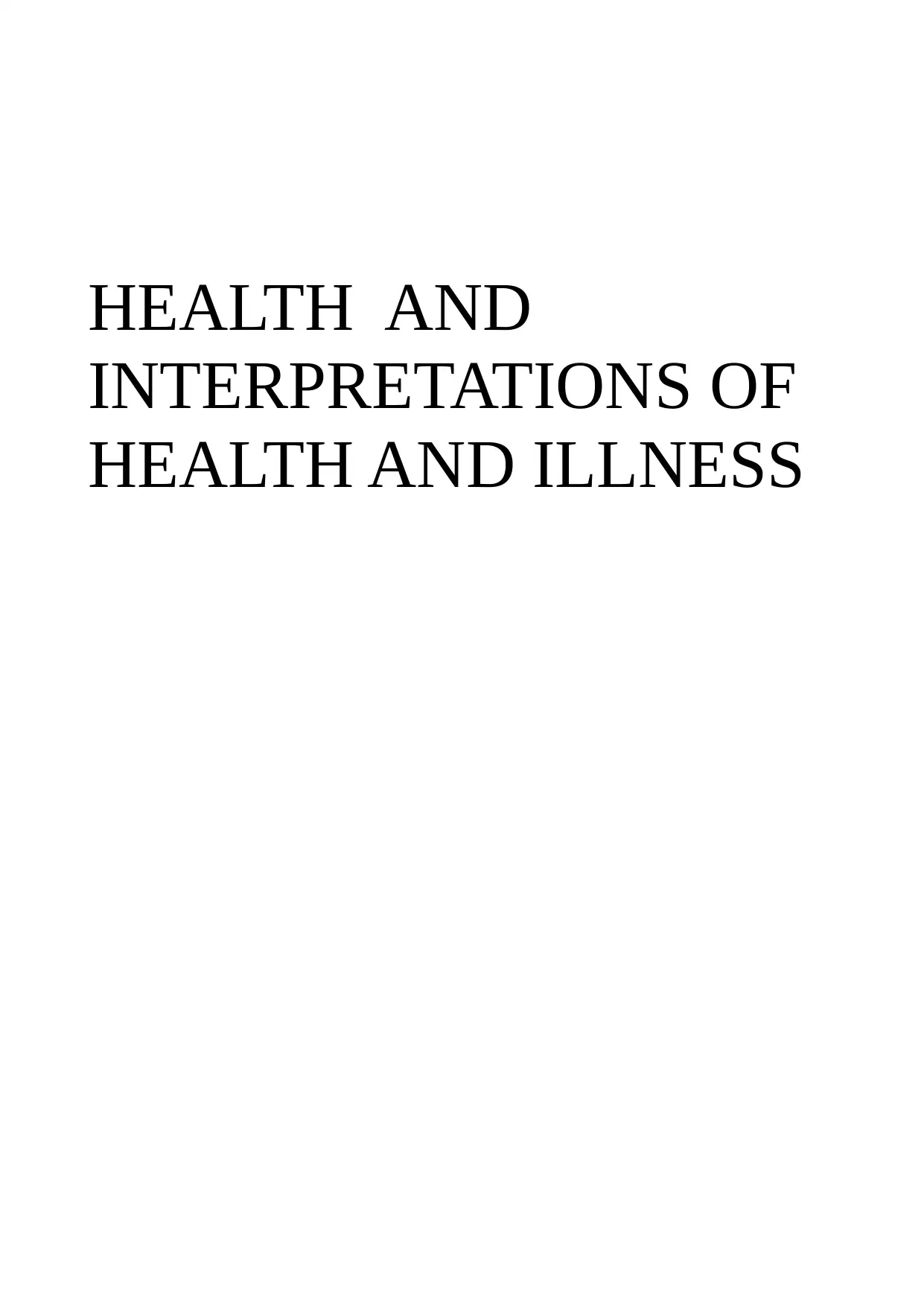
HEALTH AND
INTERPRETATIONS OF
HEALTH AND ILLNESS
INTERPRETATIONS OF
HEALTH AND ILLNESS
Paraphrase This Document
Need a fresh take? Get an instant paraphrase of this document with our AI Paraphraser
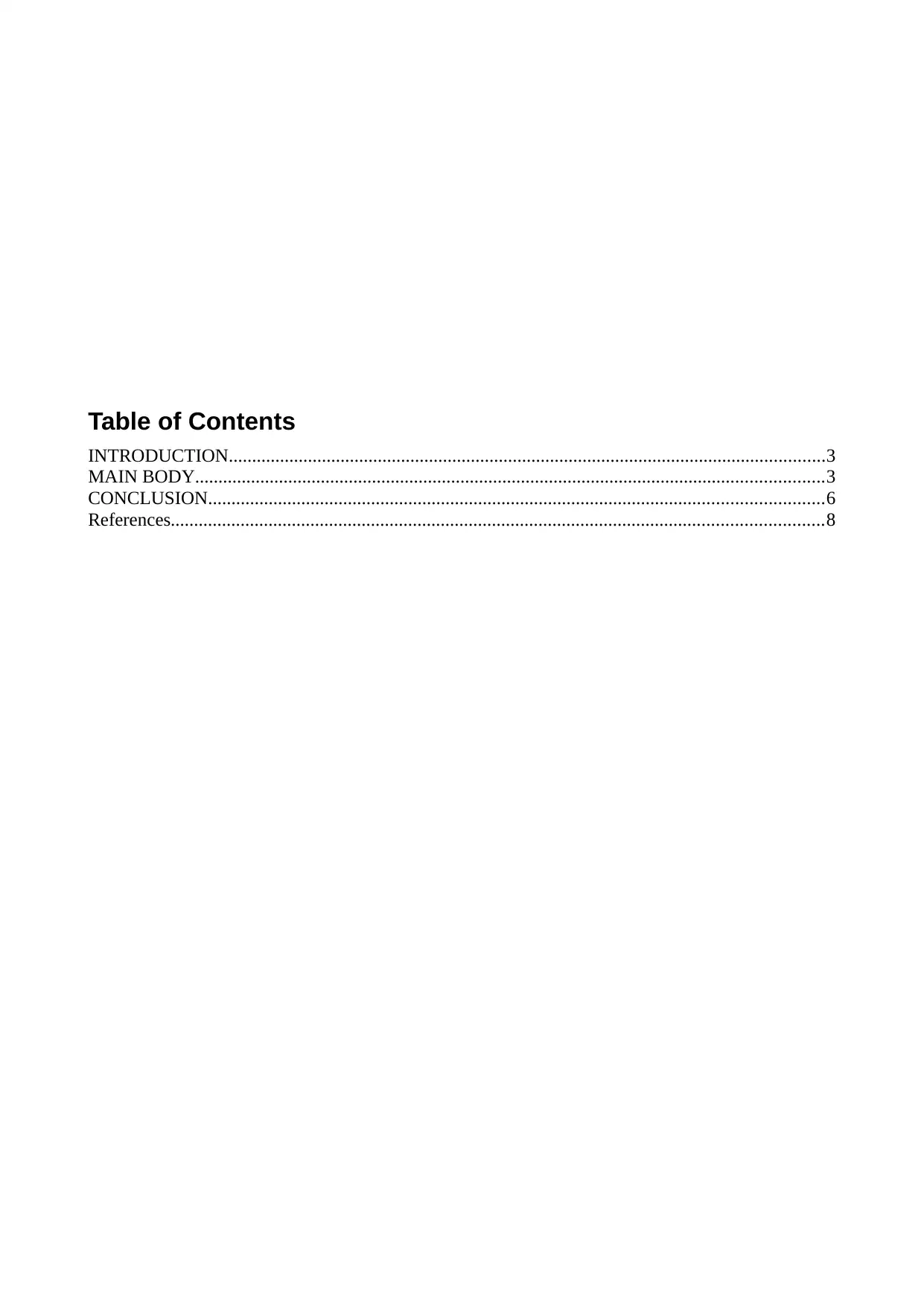
Table of Contents
INTRODUCTION................................................................................................................................3
MAIN BODY.......................................................................................................................................3
CONCLUSION....................................................................................................................................6
References............................................................................................................................................8
INTRODUCTION................................................................................................................................3
MAIN BODY.......................................................................................................................................3
CONCLUSION....................................................................................................................................6
References............................................................................................................................................8
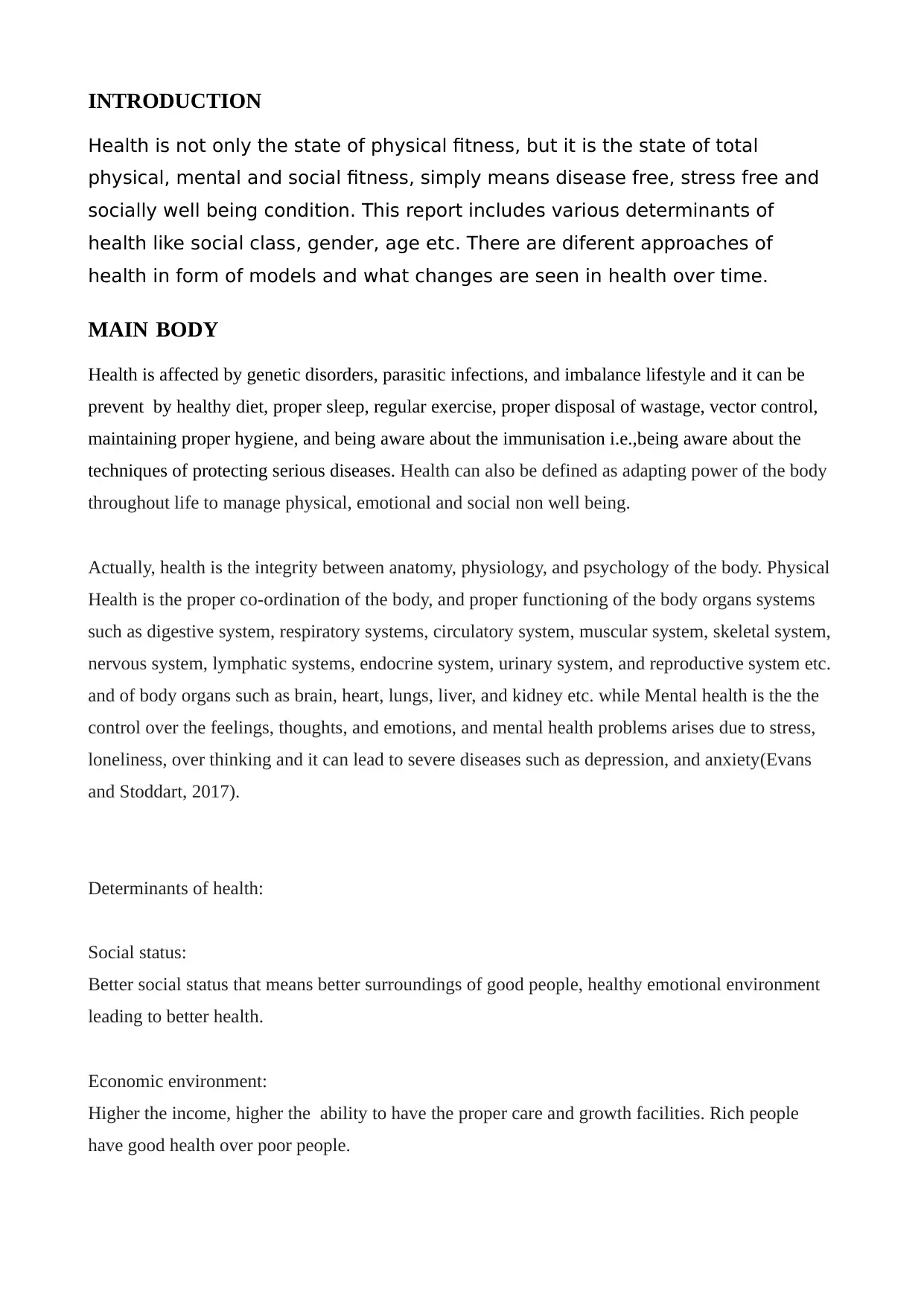
INTRODUCTION
Health is not only the state of physical fitness, but it is the state of total
physical, mental and social fitness, simply means disease free, stress free and
socially well being condition. This report includes various determinants of
health like social class, gender, age etc. There are diferent approaches of
health in form of models and what changes are seen in health over time.
MAIN BODY
Health is affected by genetic disorders, parasitic infections, and imbalance lifestyle and it can be
prevent by healthy diet, proper sleep, regular exercise, proper disposal of wastage, vector control,
maintaining proper hygiene, and being aware about the immunisation i.e.,being aware about the
techniques of protecting serious diseases. Health can also be defined as adapting power of the body
throughout life to manage physical, emotional and social non well being.
Actually, health is the integrity between anatomy, physiology, and psychology of the body. Physical
Health is the proper co-ordination of the body, and proper functioning of the body organs systems
such as digestive system, respiratory systems, circulatory system, muscular system, skeletal system,
nervous system, lymphatic systems, endocrine system, urinary system, and reproductive system etc.
and of body organs such as brain, heart, lungs, liver, and kidney etc. while Mental health is the the
control over the feelings, thoughts, and emotions, and mental health problems arises due to stress,
loneliness, over thinking and it can lead to severe diseases such as depression, and anxiety(Evans
and Stoddart, 2017).
Determinants of health:
Social status:
Better social status that means better surroundings of good people, healthy emotional environment
leading to better health.
Economic environment:
Higher the income, higher the ability to have the proper care and growth facilities. Rich people
have good health over poor people.
Health is not only the state of physical fitness, but it is the state of total
physical, mental and social fitness, simply means disease free, stress free and
socially well being condition. This report includes various determinants of
health like social class, gender, age etc. There are diferent approaches of
health in form of models and what changes are seen in health over time.
MAIN BODY
Health is affected by genetic disorders, parasitic infections, and imbalance lifestyle and it can be
prevent by healthy diet, proper sleep, regular exercise, proper disposal of wastage, vector control,
maintaining proper hygiene, and being aware about the immunisation i.e.,being aware about the
techniques of protecting serious diseases. Health can also be defined as adapting power of the body
throughout life to manage physical, emotional and social non well being.
Actually, health is the integrity between anatomy, physiology, and psychology of the body. Physical
Health is the proper co-ordination of the body, and proper functioning of the body organs systems
such as digestive system, respiratory systems, circulatory system, muscular system, skeletal system,
nervous system, lymphatic systems, endocrine system, urinary system, and reproductive system etc.
and of body organs such as brain, heart, lungs, liver, and kidney etc. while Mental health is the the
control over the feelings, thoughts, and emotions, and mental health problems arises due to stress,
loneliness, over thinking and it can lead to severe diseases such as depression, and anxiety(Evans
and Stoddart, 2017).
Determinants of health:
Social status:
Better social status that means better surroundings of good people, healthy emotional environment
leading to better health.
Economic environment:
Higher the income, higher the ability to have the proper care and growth facilities. Rich people
have good health over poor people.
⊘ This is a preview!⊘
Do you want full access?
Subscribe today to unlock all pages.

Trusted by 1+ million students worldwide
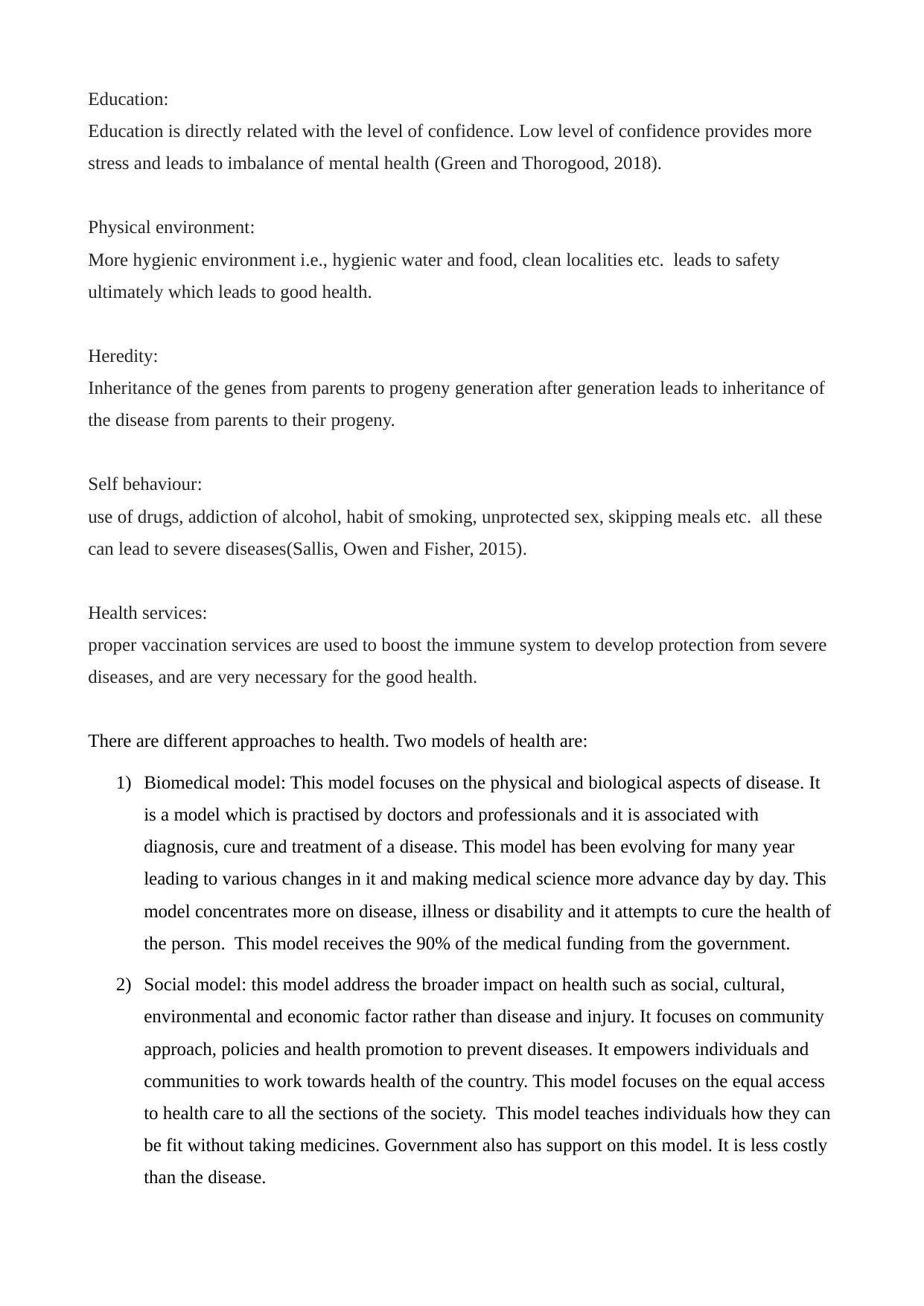
Education:
Education is directly related with the level of confidence. Low level of confidence provides more
stress and leads to imbalance of mental health (Green and Thorogood, 2018).
Physical environment:
More hygienic environment i.e., hygienic water and food, clean localities etc. leads to safety
ultimately which leads to good health.
Heredity:
Inheritance of the genes from parents to progeny generation after generation leads to inheritance of
the disease from parents to their progeny.
Self behaviour:
use of drugs, addiction of alcohol, habit of smoking, unprotected sex, skipping meals etc. all these
can lead to severe diseases(Sallis, Owen and Fisher, 2015).
Health services:
proper vaccination services are used to boost the immune system to develop protection from severe
diseases, and are very necessary for the good health.
There are different approaches to health. Two models of health are:
1) Biomedical model: This model focuses on the physical and biological aspects of disease. It
is a model which is practised by doctors and professionals and it is associated with
diagnosis, cure and treatment of a disease. This model has been evolving for many year
leading to various changes in it and making medical science more advance day by day. This
model concentrates more on disease, illness or disability and it attempts to cure the health of
the person. This model receives the 90% of the medical funding from the government.
2) Social model: this model address the broader impact on health such as social, cultural,
environmental and economic factor rather than disease and injury. It focuses on community
approach, policies and health promotion to prevent diseases. It empowers individuals and
communities to work towards health of the country. This model focuses on the equal access
to health care to all the sections of the society. This model teaches individuals how they can
be fit without taking medicines. Government also has support on this model. It is less costly
than the disease.
Education is directly related with the level of confidence. Low level of confidence provides more
stress and leads to imbalance of mental health (Green and Thorogood, 2018).
Physical environment:
More hygienic environment i.e., hygienic water and food, clean localities etc. leads to safety
ultimately which leads to good health.
Heredity:
Inheritance of the genes from parents to progeny generation after generation leads to inheritance of
the disease from parents to their progeny.
Self behaviour:
use of drugs, addiction of alcohol, habit of smoking, unprotected sex, skipping meals etc. all these
can lead to severe diseases(Sallis, Owen and Fisher, 2015).
Health services:
proper vaccination services are used to boost the immune system to develop protection from severe
diseases, and are very necessary for the good health.
There are different approaches to health. Two models of health are:
1) Biomedical model: This model focuses on the physical and biological aspects of disease. It
is a model which is practised by doctors and professionals and it is associated with
diagnosis, cure and treatment of a disease. This model has been evolving for many year
leading to various changes in it and making medical science more advance day by day. This
model concentrates more on disease, illness or disability and it attempts to cure the health of
the person. This model receives the 90% of the medical funding from the government.
2) Social model: this model address the broader impact on health such as social, cultural,
environmental and economic factor rather than disease and injury. It focuses on community
approach, policies and health promotion to prevent diseases. It empowers individuals and
communities to work towards health of the country. This model focuses on the equal access
to health care to all the sections of the society. This model teaches individuals how they can
be fit without taking medicines. Government also has support on this model. It is less costly
than the disease.
Paraphrase This Document
Need a fresh take? Get an instant paraphrase of this document with our AI Paraphraser
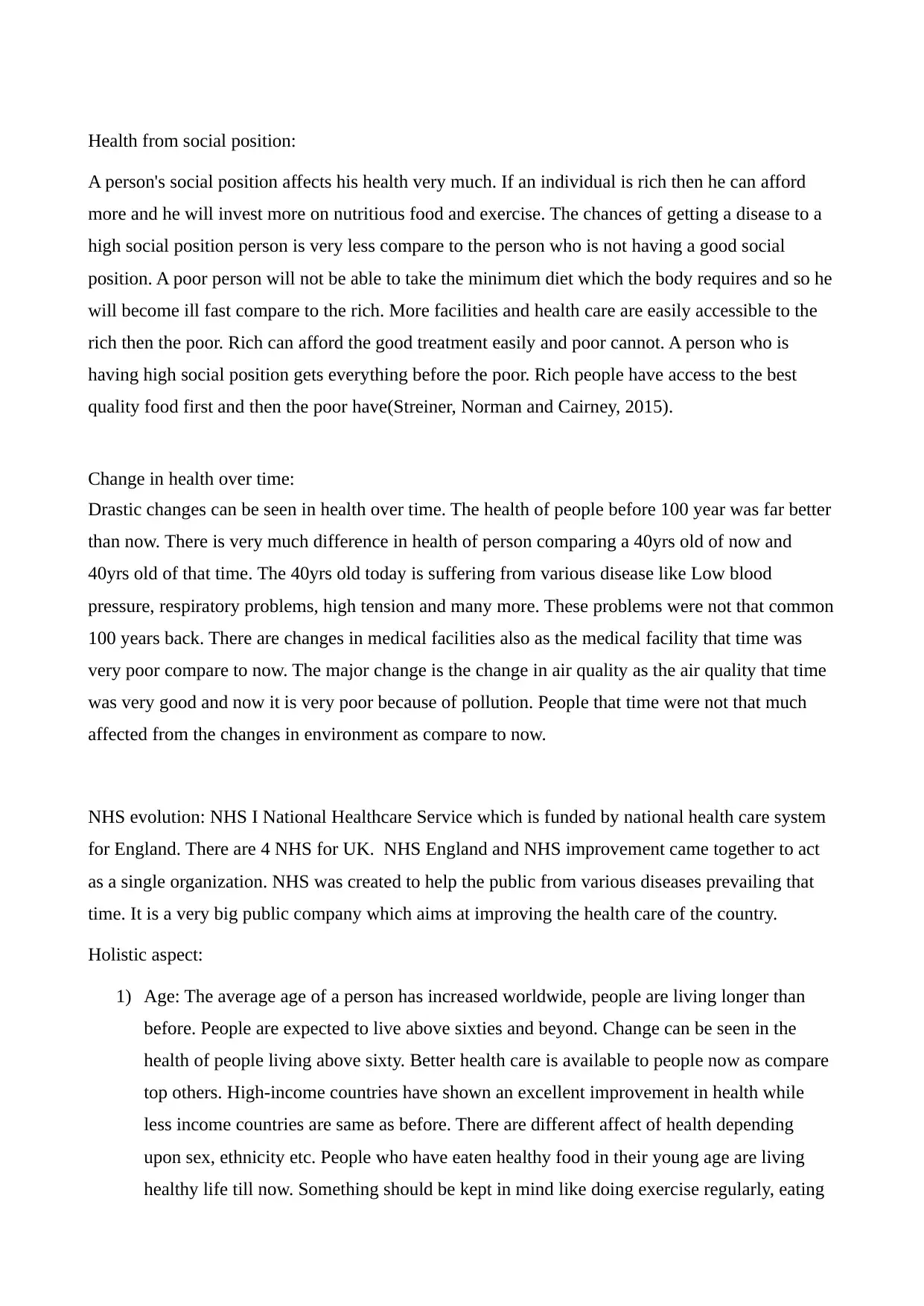
Health from social position:
A person's social position affects his health very much. If an individual is rich then he can afford
more and he will invest more on nutritious food and exercise. The chances of getting a disease to a
high social position person is very less compare to the person who is not having a good social
position. A poor person will not be able to take the minimum diet which the body requires and so he
will become ill fast compare to the rich. More facilities and health care are easily accessible to the
rich then the poor. Rich can afford the good treatment easily and poor cannot. A person who is
having high social position gets everything before the poor. Rich people have access to the best
quality food first and then the poor have(Streiner, Norman and Cairney, 2015).
Change in health over time:
Drastic changes can be seen in health over time. The health of people before 100 year was far better
than now. There is very much difference in health of person comparing a 40yrs old of now and
40yrs old of that time. The 40yrs old today is suffering from various disease like Low blood
pressure, respiratory problems, high tension and many more. These problems were not that common
100 years back. There are changes in medical facilities also as the medical facility that time was
very poor compare to now. The major change is the change in air quality as the air quality that time
was very good and now it is very poor because of pollution. People that time were not that much
affected from the changes in environment as compare to now.
NHS evolution: NHS I National Healthcare Service which is funded by national health care system
for England. There are 4 NHS for UK. NHS England and NHS improvement came together to act
as a single organization. NHS was created to help the public from various diseases prevailing that
time. It is a very big public company which aims at improving the health care of the country.
Holistic aspect:
1) Age: The average age of a person has increased worldwide, people are living longer than
before. People are expected to live above sixties and beyond. Change can be seen in the
health of people living above sixty. Better health care is available to people now as compare
top others. High-income countries have shown an excellent improvement in health while
less income countries are same as before. There are different affect of health depending
upon sex, ethnicity etc. People who have eaten healthy food in their young age are living
healthy life till now. Something should be kept in mind like doing exercise regularly, eating
A person's social position affects his health very much. If an individual is rich then he can afford
more and he will invest more on nutritious food and exercise. The chances of getting a disease to a
high social position person is very less compare to the person who is not having a good social
position. A poor person will not be able to take the minimum diet which the body requires and so he
will become ill fast compare to the rich. More facilities and health care are easily accessible to the
rich then the poor. Rich can afford the good treatment easily and poor cannot. A person who is
having high social position gets everything before the poor. Rich people have access to the best
quality food first and then the poor have(Streiner, Norman and Cairney, 2015).
Change in health over time:
Drastic changes can be seen in health over time. The health of people before 100 year was far better
than now. There is very much difference in health of person comparing a 40yrs old of now and
40yrs old of that time. The 40yrs old today is suffering from various disease like Low blood
pressure, respiratory problems, high tension and many more. These problems were not that common
100 years back. There are changes in medical facilities also as the medical facility that time was
very poor compare to now. The major change is the change in air quality as the air quality that time
was very good and now it is very poor because of pollution. People that time were not that much
affected from the changes in environment as compare to now.
NHS evolution: NHS I National Healthcare Service which is funded by national health care system
for England. There are 4 NHS for UK. NHS England and NHS improvement came together to act
as a single organization. NHS was created to help the public from various diseases prevailing that
time. It is a very big public company which aims at improving the health care of the country.
Holistic aspect:
1) Age: The average age of a person has increased worldwide, people are living longer than
before. People are expected to live above sixties and beyond. Change can be seen in the
health of people living above sixty. Better health care is available to people now as compare
top others. High-income countries have shown an excellent improvement in health while
less income countries are same as before. There are different affect of health depending
upon sex, ethnicity etc. People who have eaten healthy food in their young age are living
healthy life till now. Something should be kept in mind like doing exercise regularly, eating
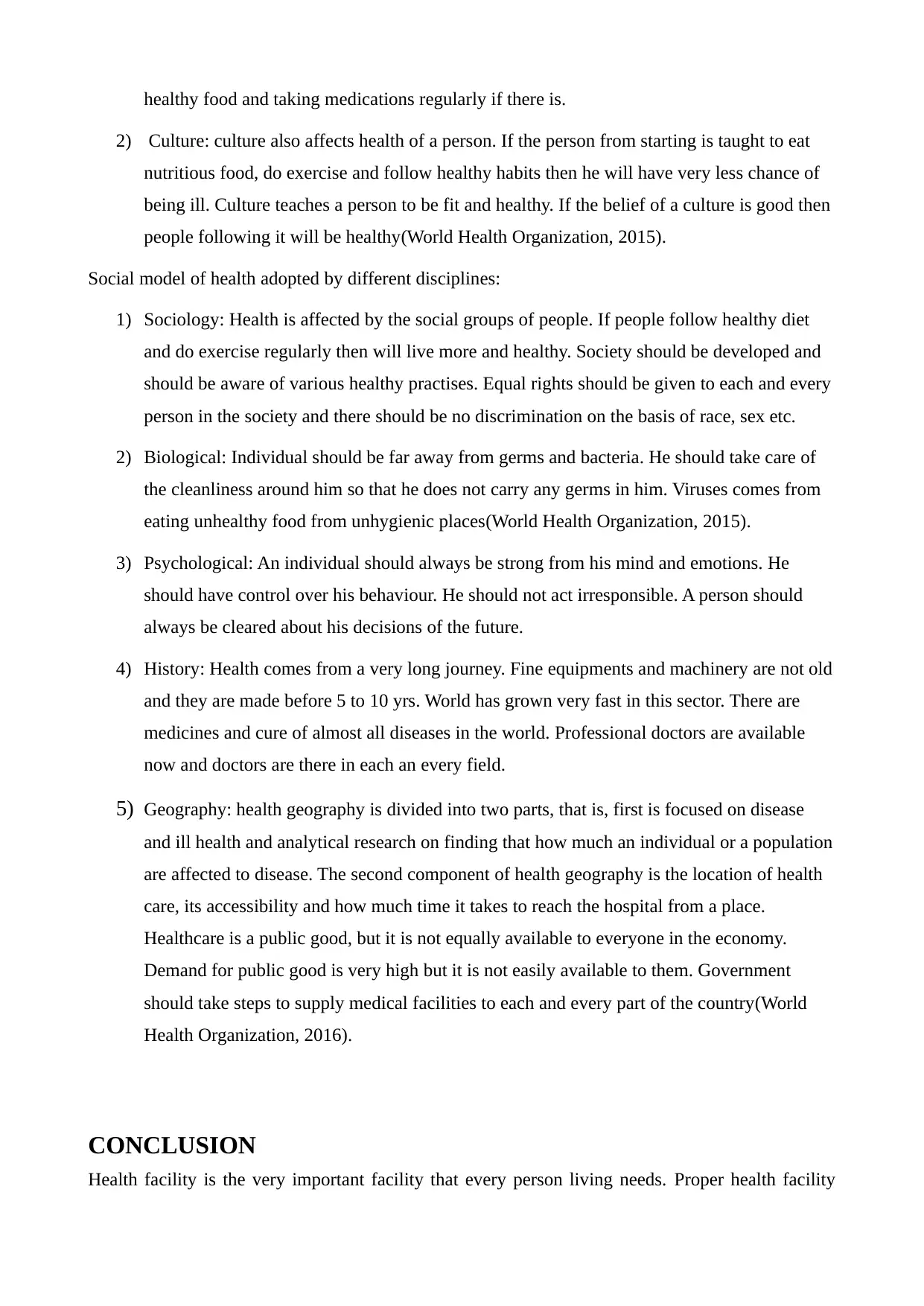
healthy food and taking medications regularly if there is.
2) Culture: culture also affects health of a person. If the person from starting is taught to eat
nutritious food, do exercise and follow healthy habits then he will have very less chance of
being ill. Culture teaches a person to be fit and healthy. If the belief of a culture is good then
people following it will be healthy(World Health Organization, 2015).
Social model of health adopted by different disciplines:
1) Sociology: Health is affected by the social groups of people. If people follow healthy diet
and do exercise regularly then will live more and healthy. Society should be developed and
should be aware of various healthy practises. Equal rights should be given to each and every
person in the society and there should be no discrimination on the basis of race, sex etc.
2) Biological: Individual should be far away from germs and bacteria. He should take care of
the cleanliness around him so that he does not carry any germs in him. Viruses comes from
eating unhealthy food from unhygienic places(World Health Organization, 2015).
3) Psychological: An individual should always be strong from his mind and emotions. He
should have control over his behaviour. He should not act irresponsible. A person should
always be cleared about his decisions of the future.
4) History: Health comes from a very long journey. Fine equipments and machinery are not old
and they are made before 5 to 10 yrs. World has grown very fast in this sector. There are
medicines and cure of almost all diseases in the world. Professional doctors are available
now and doctors are there in each an every field.
5) Geography: health geography is divided into two parts, that is, first is focused on disease
and ill health and analytical research on finding that how much an individual or a population
are affected to disease. The second component of health geography is the location of health
care, its accessibility and how much time it takes to reach the hospital from a place.
Healthcare is a public good, but it is not equally available to everyone in the economy.
Demand for public good is very high but it is not easily available to them. Government
should take steps to supply medical facilities to each and every part of the country(World
Health Organization, 2016).
CONCLUSION
Health facility is the very important facility that every person living needs. Proper health facility
2) Culture: culture also affects health of a person. If the person from starting is taught to eat
nutritious food, do exercise and follow healthy habits then he will have very less chance of
being ill. Culture teaches a person to be fit and healthy. If the belief of a culture is good then
people following it will be healthy(World Health Organization, 2015).
Social model of health adopted by different disciplines:
1) Sociology: Health is affected by the social groups of people. If people follow healthy diet
and do exercise regularly then will live more and healthy. Society should be developed and
should be aware of various healthy practises. Equal rights should be given to each and every
person in the society and there should be no discrimination on the basis of race, sex etc.
2) Biological: Individual should be far away from germs and bacteria. He should take care of
the cleanliness around him so that he does not carry any germs in him. Viruses comes from
eating unhealthy food from unhygienic places(World Health Organization, 2015).
3) Psychological: An individual should always be strong from his mind and emotions. He
should have control over his behaviour. He should not act irresponsible. A person should
always be cleared about his decisions of the future.
4) History: Health comes from a very long journey. Fine equipments and machinery are not old
and they are made before 5 to 10 yrs. World has grown very fast in this sector. There are
medicines and cure of almost all diseases in the world. Professional doctors are available
now and doctors are there in each an every field.
5) Geography: health geography is divided into two parts, that is, first is focused on disease
and ill health and analytical research on finding that how much an individual or a population
are affected to disease. The second component of health geography is the location of health
care, its accessibility and how much time it takes to reach the hospital from a place.
Healthcare is a public good, but it is not equally available to everyone in the economy.
Demand for public good is very high but it is not easily available to them. Government
should take steps to supply medical facilities to each and every part of the country(World
Health Organization, 2016).
CONCLUSION
Health facility is the very important facility that every person living needs. Proper health facility
⊘ This is a preview!⊘
Do you want full access?
Subscribe today to unlock all pages.

Trusted by 1+ million students worldwide
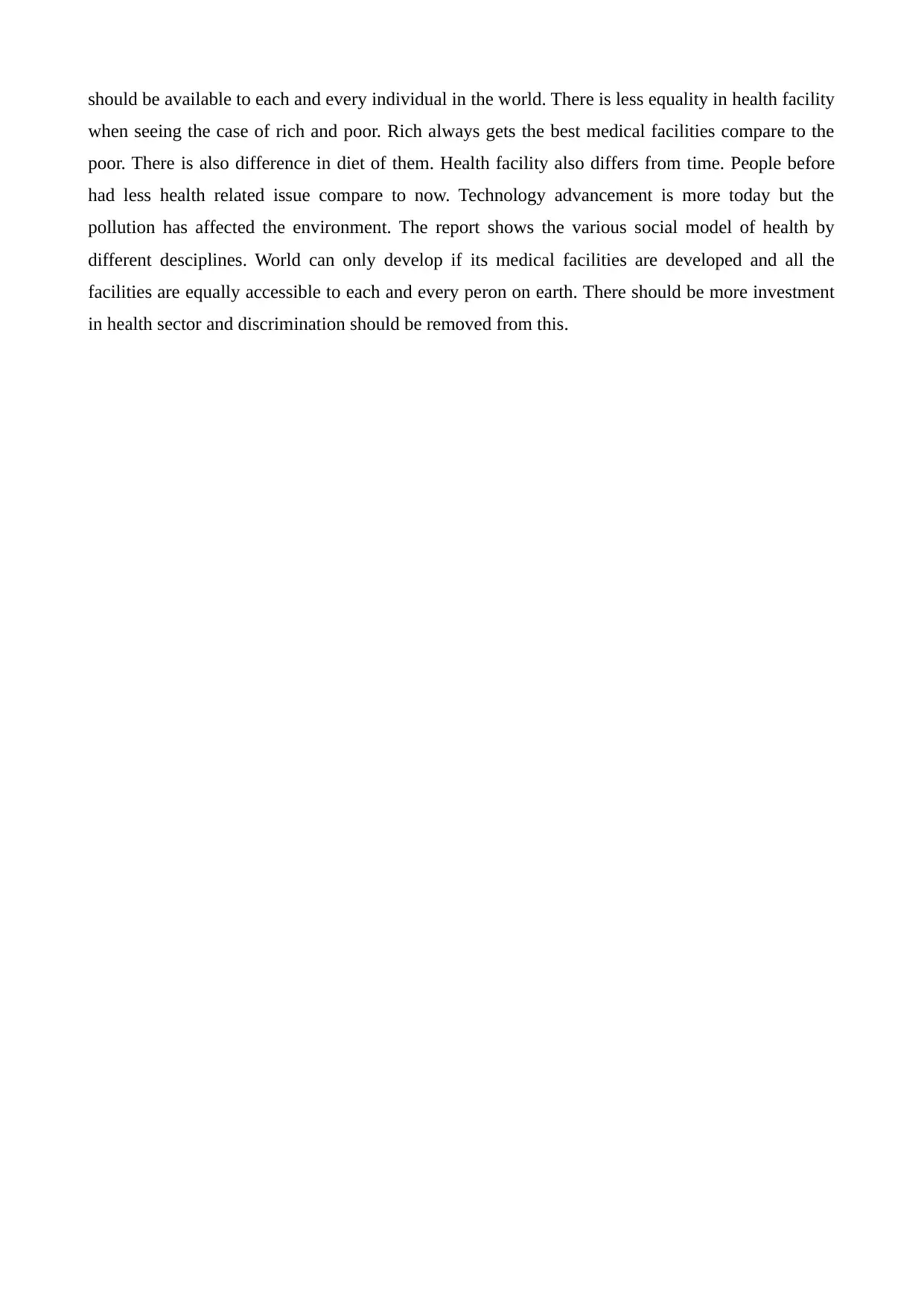
should be available to each and every individual in the world. There is less equality in health facility
when seeing the case of rich and poor. Rich always gets the best medical facilities compare to the
poor. There is also difference in diet of them. Health facility also differs from time. People before
had less health related issue compare to now. Technology advancement is more today but the
pollution has affected the environment. The report shows the various social model of health by
different desciplines. World can only develop if its medical facilities are developed and all the
facilities are equally accessible to each and every peron on earth. There should be more investment
in health sector and discrimination should be removed from this.
when seeing the case of rich and poor. Rich always gets the best medical facilities compare to the
poor. There is also difference in diet of them. Health facility also differs from time. People before
had less health related issue compare to now. Technology advancement is more today but the
pollution has affected the environment. The report shows the various social model of health by
different desciplines. World can only develop if its medical facilities are developed and all the
facilities are equally accessible to each and every peron on earth. There should be more investment
in health sector and discrimination should be removed from this.
Paraphrase This Document
Need a fresh take? Get an instant paraphrase of this document with our AI Paraphraser
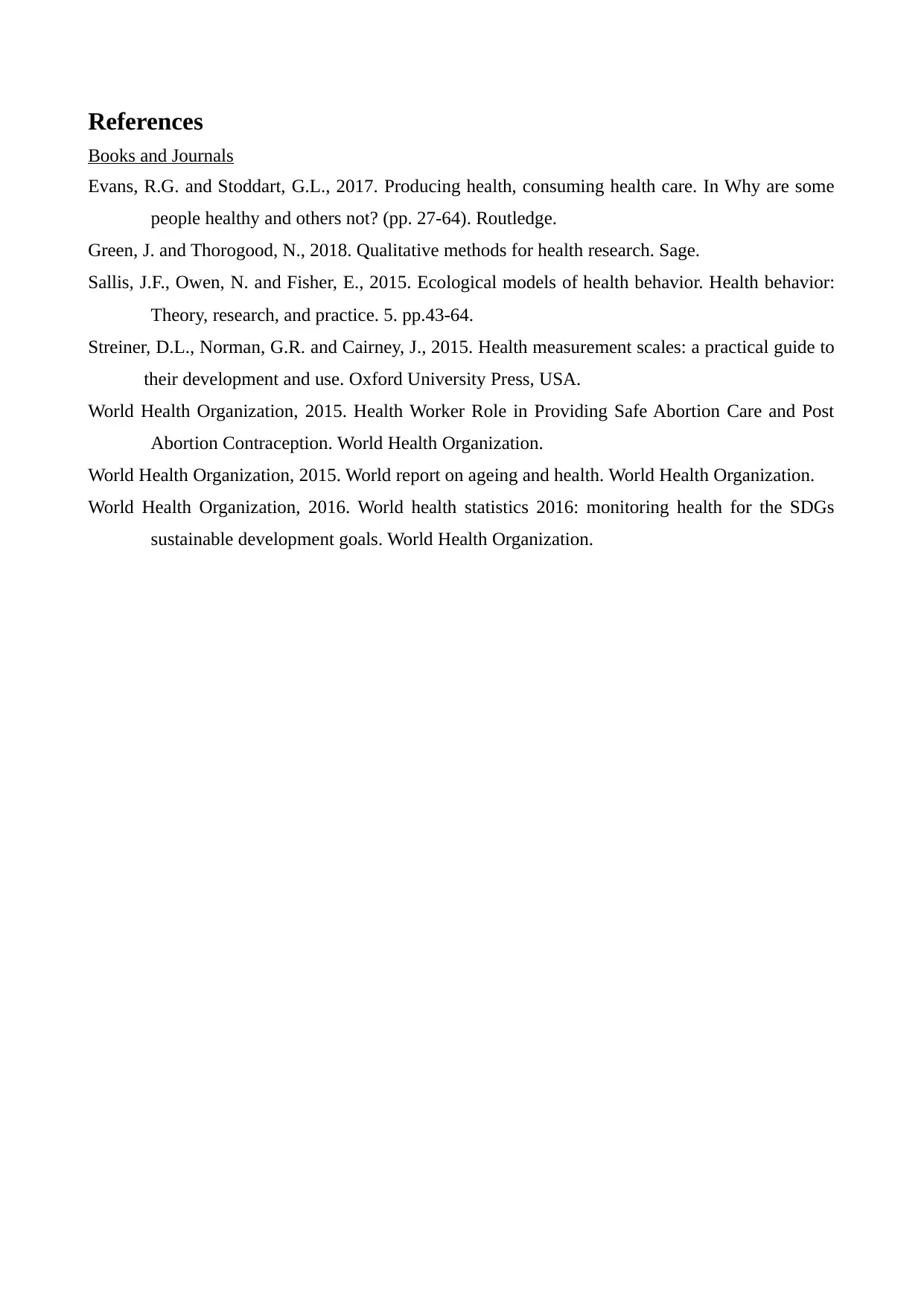
References
Books and Journals
Evans, R.G. and Stoddart, G.L., 2017. Producing health, consuming health care. In Why are some
people healthy and others not? (pp. 27-64). Routledge.
Green, J. and Thorogood, N., 2018. Qualitative methods for health research. Sage.
Sallis, J.F., Owen, N. and Fisher, E., 2015. Ecological models of health behavior. Health behavior:
Theory, research, and practice. 5. pp.43-64.
Streiner, D.L., Norman, G.R. and Cairney, J., 2015. Health measurement scales: a practical guide to
their development and use. Oxford University Press, USA.
World Health Organization, 2015. Health Worker Role in Providing Safe Abortion Care and Post
Abortion Contraception. World Health Organization.
World Health Organization, 2015. World report on ageing and health. World Health Organization.
World Health Organization, 2016. World health statistics 2016: monitoring health for the SDGs
sustainable development goals. World Health Organization.
Books and Journals
Evans, R.G. and Stoddart, G.L., 2017. Producing health, consuming health care. In Why are some
people healthy and others not? (pp. 27-64). Routledge.
Green, J. and Thorogood, N., 2018. Qualitative methods for health research. Sage.
Sallis, J.F., Owen, N. and Fisher, E., 2015. Ecological models of health behavior. Health behavior:
Theory, research, and practice. 5. pp.43-64.
Streiner, D.L., Norman, G.R. and Cairney, J., 2015. Health measurement scales: a practical guide to
their development and use. Oxford University Press, USA.
World Health Organization, 2015. Health Worker Role in Providing Safe Abortion Care and Post
Abortion Contraception. World Health Organization.
World Health Organization, 2015. World report on ageing and health. World Health Organization.
World Health Organization, 2016. World health statistics 2016: monitoring health for the SDGs
sustainable development goals. World Health Organization.
1 out of 8
Related Documents
Your All-in-One AI-Powered Toolkit for Academic Success.
+13062052269
info@desklib.com
Available 24*7 on WhatsApp / Email
![[object Object]](/_next/static/media/star-bottom.7253800d.svg)
Unlock your academic potential
Copyright © 2020–2025 A2Z Services. All Rights Reserved. Developed and managed by ZUCOL.



